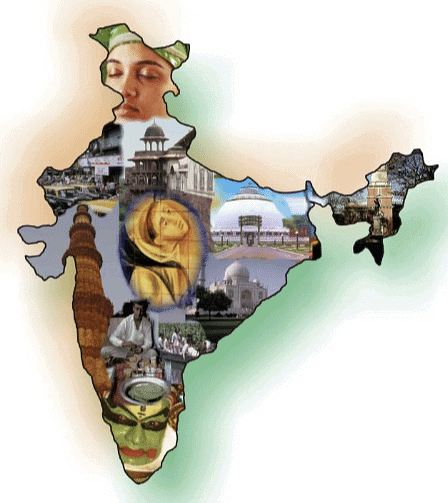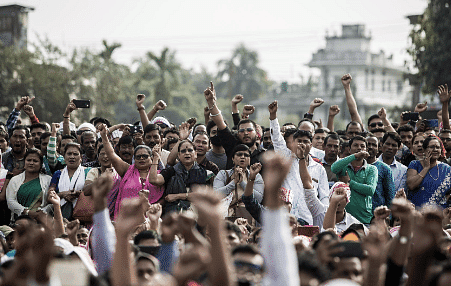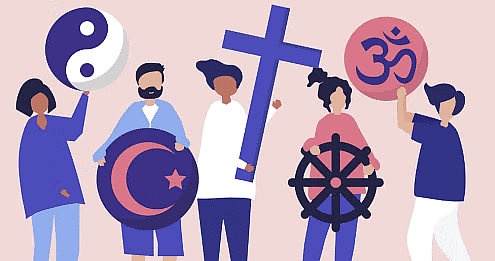Challenges of Cultural Diversity Class 12 Sociology
| Table of contents |

|
| Introduction |

|
| The Importance of Community Identity |

|
| Regionalism in the Indian Context |

|
| Religion-Related Issue and Identities |

|
| State and Civil Society |

|
Introduction
- Cultural traits such as language, religion, sect, race, or caste can help identify communities.
- The challenges emerge from the robustness of cultural identities, which can generate intense emotions and often bring together large groups of people.
- This is further complicated when economic and social inequality coincides with cultural disparities.
- Efforts to address injustices or inequalities experienced by one community may face opposition from other communities.
- The situation worsens when there is a scarcity of resources like river waters, jobs, or government funds that need to be shared.

The Importance of Community Identity
- Community identification is not based on any acquired qualifications or achievements, but on birth and a sense of belonging. It is not about what we have accomplished, but rather about who we are. No one has any control over the family, community, or nation they are born into, so there is no need to take any action to belong to one.
- Ascriptive identities and community emotions are universal, present in every religion and nation, in terms of mother tongue or culture, values, beliefs, and so on. Appreciating these concepts is crucial since community identity is typically ascribed. One has no choice but to embrace all of them, and once one falls in love with them, no one can object. However, this is largely an individual experience.
- When two nations or groups are in conflict, it is rare for either to admit that they are at fault, even if one or both are mistaken
Communities, Nation, Nation State
Nation
- A nation refers to a large group of people who have their own territory, people, government, and sovereignty. The desire to belong to the same political entity is a shared sentiment among all citizens of a country. The manifestation of this yearning for political unification is typically through the establishment of a state. Countries may not necessarily share a common language, religion, race, or other characteristics, while many different countries may share multiple races, faiths, and languages.

State
- A state is an abstract entity consisting of several political and legal institutions that assert power over a particular physical territory and its inhabitants. Max Weber's definition of a state is "a body that successfully claims a monopoly of legitimate power in a given territory." A group that can effectively assert itself as a legal power in a particular region is referred to as a state.
Colonial Rule and Nation-State
- India became a separate nation-state in 1947 after its division. Bangladesh and Pakistan united to create the nation-state of Pakistan, which later separated due to administrative difficulties. Another issue was that Bangladesh's official language, Bangla, made it difficult for Pakistan to choose Urdu as its national language.
USSR-Union of Soviet Socialist Republic
- The USSR was a country-state with numerous neighboring nations, each with its culture and state-nation, but the government held power, and the people had no say. It collapsed in 1991.
Dual Citizenship of Israeli's in the USA
- In the USA, only Jews born and raised there are granted citizenship, and they are the only ones who can obtain dual citizenship.
Policies (India follows both)
- Policy of Assimilation: This policy requires that everyone adheres to a single standard, culture, value, and tenet. The majority has more power, so the entire nation follows them. For example, in India, where Hindus are the majority, there are many more festivals than for Christians or Parsis.
- Policy of Integration: Under this policy, people maintain their non-material culture in private but follow the national culture or patterns in public. For instance, Jana Gana Mana is India's national anthem, not Vande Mataram. The already established nations consider minority identities as potential threats because they may serve as the foundation for country-building. For example, Sikhs in Khalistan desired their own homeland.
States prefer a single, uniform national identity to promote unity and togetherness, but this does not mean the minority's identity should be stifled. Doing so may result in uprisings and division, rather than unification. Therefore, the government allows people to maintain their cultural differences to promote peace and harmony throughout the nation.
Cultural Diversity and India as a Nation-state
- The majority of people in India are Muslims after Indonesia and Pakistan.
- India upholds secularism by allowing people to practise and propagate their religions, and reservations are made for minorities.
Language
- India has 1632 official languages, but there are 18 official ones including Hindi, Gujarati, Marathi, English, Punjabi, and Urdu.
- Hindi and English are the languages used in government documents, except for the Constitution which is in English.
- Language played a role in preserving India's unity, and it is a unifying factor that promotes effective communication and state boards for educational purposes.
- Under Nehru, the country was divided along linguistic lines, leading to the creation of states like Andhra Pradesh.
- While language can serve as a powerful unifying force, regional disparities can still exist.
Regionalism in the Indian Context
- Regionalism is the phenomenon of the existence of diverse cultures, languages, regions, castes, and tribes in India.
- Language has played a significant role in preserving the unity of the country.
- After gaining independence, India decided to adopt the British model of leading the presidency.
- The princely states of Bombay, Madras, and Calcutta were composed of people who spoke different languages like Malayalam, Tamil, Telugu, and Kannada.
- Language is a unifying factor that can promote effective communication, unification, state boards (for educational purposes), and linguism can disseminate love for language.
- Under Nehru's leadership, the country was divided along linguistic lines, which he initially hesitated about but later believed was beneficial.

- This resulted in the division of the Madras Presidency into three states, which caused dissatisfaction among the Telugu people.
- They demanded a separate state after Tamilians were given more significant positions and became dominant.
- Potti Sriramulu went on a hunger strike to demand a separate state for Telugu speakers.
- Following his death, protests continued, and in 1956, the government granted Andhra Pradesh to the Telugu people, who had the option to move to Andhra Pradesh or remain in the Madras state.
- Although language serves as a powerful unifying force, regional disparities can still exist.
- In Sri Lanka, Tamilians desired equal treatment with Sinhalas, the main language, and official parliamentary administration.
- In an effort to aid the populace, the LTTE was founded, resulting in the murder of Rajiv Gandhi
Religion-Related Issue and Identities
- In sociology, religion and majority and minority are interconnected.
- Minorities refer to those who are numerically smaller than the majorities of any religion.
- In India, Hindus make up the majority with 81% of the population.
Minority Rights and Nation Building
Inclusive Nationalism
- Inclusive nationalism is when all religions work together for the betterment of the nation, creating unity in diversity.
- Even though we acknowledge differences and variations, we still come together for the common good.
- We strive to eradicate discrimination and establish a democratic system.

Exclusive nationalism
- Exclusive nationalism is when each faith follows what they consider best for the nation.
- The most effective approach for the country's progress is to adopt inclusive thinking, where all societal segments (including minorities) are taken care of in the constitution.
- During the writing of the constitution, the Constituent Assembly attempted to include social, political, and economic fairness.
Features of Minority
- Sociologically, religion and minority are interconnected, and minorities are those who have fewer numbers than majorities.
- Minorities have unfulfilled needs and have less opportunity compared to the majority.
- They often face discrimination and feel insecure due to their smaller size.
- Despite their differences, minorities have a sense of unity and collective belonging, and they work together to defend their rights.
- Some communities, such as Jains and Parsis, have strong economies but lack cultural and social structures.
- Minorities feel a sense of allegiance to their country.
Policies and Minorities
- Political parties can easily convert electoral victories into political power.
- Minorities are unpredictable and at risk, and a "minority block" is formed as a result.
- They may have to compromise their identities to maintain their employment.
- The Constitution of India guarantees freedom of religion to every citizen, and minorities are protected under Articles 29 and 30.
- Article 30 allows any religious group to establish educational institutions, and minorities should have access to all amenities provided to other groups.
- For the sake of nationalharmony, no one should be forced to accept any particular faith.
- In Europe, Christians make up the majority, while Jews, Sikhs, and other minorities are Hindus.
Communalism, Secularism and the Nation-State
Communalism
- Your strong religious devotion has led you to hold all other religions in low esteem.
- Communalism is defined by Westerners as a group of individuals collaborating towards a shared objective.
- In India, politicians exploit religious affiliations to secure votes, indicating that communalism is more about politics than religion, with reserved seats for different faiths.
- India's diversity makes communalism a problem wherever there are large populations with varying backgrounds.
- Communalism is a violent political philosophy intertwined with a specific religion, indicating an unhealthy attachment to one's faith.
- Communalists adopt an aggressive political identity that dismisses all other religions and incites riots within their own community.
- One community may seek revenge for past injustices committed against another community, either to restore lost pride or to protect their neighborhood.
- Riots are characterized by constant violence, death, destruction of property, assault, looting, and sexual assault.
- Each time a riot occurs within a community, the ruling party must take responsibility and protect the victims.
Secularism
- In India, secularism means that everyone has the right to freely practice, preach, and proclaim any religion of their choice, with equal weight given to all religions.
- In contrast, the Western interpretation of secularism is that the church should not be involved in political issues, and religion is generally relegated to the private sphere.
- Although secularization has progressed, religion still tends to be seen as a private matter.
- Modernity has led to the rise of secularization.
- By considering different rational viewpoints and focusing on service rather than religion, one can gain a more open perspective.

- The Indian interpretation of secularism, which emphasizes the equality of all religions, is the opposite of communalism.
- The different interpretations of secularism in the West and India pose a challenge for our country.
- The government's claim that reservations are unfair is contested by the majority, while the minority argues that they need reservations to avoid being overshadowed.
- Despite the government's efforts to protect the minority, the majority's customs and holidays are still observed, adding to the challenges of secularism.
- Political interference from parties is exacerbating these difficulties even further.
- Nevertheless, India is still a secular country that strives to care for the minority without disturbing the majority, while upholding peace, tolerance, and community harmony.
- Upon India's independence, Nehru declared that the country was a democratic, secular, and independent nation.
State and Civil Society
- Democracy is a form of government where people have a say, can elect their political leaders, and enjoy their fundamental rights.
- Authoritarianism is a form of government where civil liberties are curtailed, and citizens have no means to hold the government accountable.
- Under authoritarian rule, institutions may be powerless to address the needs of the people, such as the banks.
- Civil society refers to non-commercial, non-profit organizations that operate outside the public sphere, composed of volunteers.
- Civil societies are groups that work to protect people's rights, particularly those of oppressed groups, and may include political parties, mainstream media, NGOs, newspapers, and women's organizations.
- During the Emergency of 1975-77, there were widespread sterilization efforts that targeted both men and women using force to perform vasectomies and tubectomies.
- Civil liberties were suspended, and individuals were imprisoned without trial.
- People who spoke out against these actions and even some of the lower-level perpetrators were imprisoned, including political figure Jayaprakash Narayan.
- Following the Emergency, Indira Gandhi lost the election, and there was a national uproar.
- As a result, the importance of civil society organizations increased
Tribals, Healthcare, and Relocation
Civil Society's Role in Government Oversight:
- Civil society organizations work to ensure that government funds are used properly.
- They also monitor the application of the law, including the Right to Information Act of 2005.
- This act allows individuals to request government financial documents related to the distribution of funds and payment of taxes.
- People have the right to question the government about its decisions, but this right only applies to government actions, not those of the private sector.
FAQs on Challenges of Cultural Diversity Class 12 Sociology
| 1. What is the significance of community identity in the context of cultural diversity? |  |
| 2. How does regionalism impact cultural diversity in India? |  |
| 3. What role do religion-related issues play in shaping identities in diverse societies? |  |
| 4. How do states and civil society organizations contribute to managing cultural diversity challenges? |  |
| 5. What are some common strategies for addressing the challenges of cultural diversity in communities? |  |





















